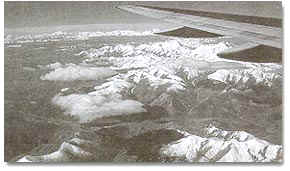

Tibet, the very name evokes feelings of awe and mystery. A land of ancient Buddhist culture, awesome landscapes, artistic monasteries, exotic cities, hidden valleys and centuries-old caravan trails, Tibet offers a totally different experience.And Kathmandu is the natural gateway to this amazing land. Once the center of the ancient trade route connecting India and Tibet, Kathmandu is perfectly positioned for its modern role as the hub of adventure tourism in the Himalaya.
Fine transport connections exist between Kathmandu and Lhasa, the capital of the Tibetan Autonomous Region of China. You can go overland on a scenic highway that retraces the old caravan trail or take a spectacular flight over the Himalaya.
LHASA
Lhasa will overwhelm you with its extraordinary sights. And it’s not only the altitude (3,650 m) that will take your breath away. The magnificent Potala Palace, former seat of the Dalai Lamas, presides over the city. Built in 1645 at the top of a hill, the palace contains 1,000 rooms, 10,000 shrines and 200,000 religious statues.
The old city revolves around the Jhokhang Temple and the quaint Bakor market that surrounds it. The Jhokhang, built in the seventh century, is the holiest Buddhist shrine in Tibet and houses the Jowo Sakyamuni brought to Tibet from Nepal. At a little distance from the old city core, Lhasa is also a modern capital of concrete high-rises, fancy department stores and wide boulevards.
Norbulingka, which means "the jeweled garden", consists of 360,000 sq m of wooded greenery and three palaces once used by the Dalai Lamas as a summer retreat. The Drepung Monastery lies about 10 km from the city. Built in 1416 by a disciple of Tsong Khapa, it is the largest in Tibet. The Sera Monastery, about 5 km north of Lhasa, is another important center of Buddhist learning. Built in 1419, it houses a nine-meter figure of Maitreya, the Buddha to come.
SHIGATSE
An excellent excursion from Lhasa is a circuit that takes in the towns of Shigatse, Gyantse and Tsetang. It offers a comprehensive experience of Tibet in a neat itinerary.
Shigatse (altitude 3,900 m) lies some 274 km to the west of Lhasa and is Tibet’s second largest city. The highway runs alongside the Yarlung Tsangpo (Brahmaputra) river passing through narrow gorges and broad river valleys. Farmers plowing their fields with yaks, sheep grazing on the vast plains, awesome sand dunes and rocky hills in the distance are the scenic rewards of this journey.
The Tashilhunpo Monastery, built in 1447 by the first Dalai Lama, contains a huge 26-meter high statue of Maitreya. Other buildings contain images of Sakyamuni (the Buddha of our times), white and green Taras and embalmed bodies of past Panchen Lamas.
GYANTSE
Shigatse to Gyantse (altitude 3,800 m) is 94 km of gravel but good road. Gyantse’s symbol is the Kumbum Stupa which is 32 m high and contains 77 rooms and 100,000 images of the Buddha. A prince of Gyantse had it built in the style of a 108-sided mandala by craftsmen from the Kathmandu Valley. It is the finest example of 15th-century Newar art extant in the world. Pelkor Chode Monastery and Gyantse Fort (built atop a massive rock) are other major sights here.
The road from Gyantse to Lhasa (260 km) takes you over three mountain passes: Simala (4,380 m high), Karola (5,045 m) and Ghampala (4,794 m). The highway skirts the Yamdrok Tso Lake before twisting up the Ghampala pass from the top of which there’s a fantastic view of the lake on one side and the Yarlung Tsangpo river on the other.
TSETANG
Tsetang (195 km from Lhasa) is known as the cradle of Tibetan civilization. The ancient town offers a number of side trips that illustrate Tibet’s early history. The Valley of the Kings (ancient capital of the Yarlung kings who established the Tibetan nation), the Yumbu Lagang Palace (built for the first Yarlung king), and the Tandruk Monastery (one of the three royal Buddhist temples) are some of the major sights.
GENERAL INFO
Tibet is a high desert plateau lying at an average elevation of 4,000 m.
Altitude sickness: Travellers may suffer from breathlessness and headaches before becoming acclimatized to the thin air. Many hotels keep bottled oxygen for emergencies.
Access: From Kathmandu, fly (1 hour) to Lhasa’s Gonggar Airport (85 km from the city). Or go overland all the way (962 km, three-six days).
Visa: A visa application for Tibet has to be made through a registered travel agency in Nepal. A visa for China does not entitle you to travel in Tibet.
Accommodation: There are tourist standard hotels with modern facilities and basic accommodation.
Transport: Buses and four-wheel drive vehicles. There are taxis, minibuses and rickshaws for getting around Lhasa.
Season: The popular time to visit Tibet is May-October. Light-weight clothes are recommended during this season. Warm clothing is required November-April
MD Publishing Co. Pvt. Ltd.,
Tripureswor, P. O. Box 3525, Kathmandu, Nepal.
Tel: 260327, 256003 . Telex: 2611 EMC NP. Fax: 977-1-261159.
E-mail:nttj@mos.com.np
.Design and Maintained by Amaa Network Consultant, Inc.
Last Updated: 24 July, 2000
Comments and Suggestions to: Webmaster